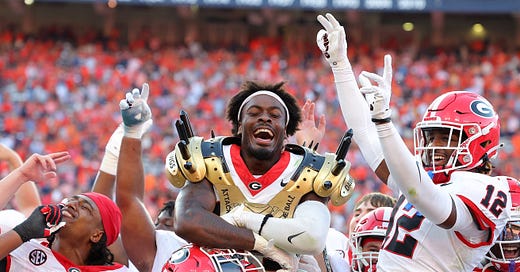Part 11, S: Why Malaki Starks, 'A+ across the board,' can run your defense
This isn't our father's safety position. Gone is the tone-setter. Yet? The position remains crucial to success. Starks, "one of the most valuable defensive players in this draft," leads the class.
This is the 41st year, and the fourth at Go Long, in which Bob McGinn has written a position-by-position series previewing the NFL draft. Previously, it appeared in the Green Bay Press-Gazette (1985-’91), the Milwaukee Journal Sentinel (1992-2017), BobMcGinnFootball.com (2018-’19) and The Athletic (2020-’21). Until 2014, many personnel people were quoted by name. Reluctantly, the series adopted an all-anonymous format in 2015 at the request of most scouts.
Eleventh of 12 parts: Safeties.
Go Long is your forever home for unvarnished NFL coverage.
By Bob McGinn
Four times in the last five drafts the safeties turned away from the first round wondering, “Hey, what about us?”
What hasn’t changed in pro football is every team still needs at least three capable safeties. What has changed is where those teams want to draft them.
In 2020, 2021, 2022 and 2024, that meant anywhere other than the first round. From 1988-2019, a span of 32 years, the first round included a safety 25 times.
Just one safety has been a top-10 pick since 2012. Only 13 have been first-round selections in the last 10 drafts.
By and large, the higher investments at the position have paid dividends. The six safeties voted to the Pro Bowl in 2024 included three from the first round (Minkah Fitzpatrick-11, Kyle Hamilton-14, Derwin James-17) and three from the first half of the second round (Budda Baker-36, Xavier McKinney-36, Brian Branch-45).
Most personnel people see this class of safeties as pedestrian. One of the overriding problems for safeties is how officiating changes have lessened their impact.
“I don’t see a lot of safeties going early just because of the way the rules are these days,” an executive in personnel said. “With all the targeting rules in college football safeties can’t enforce anymore. You can’t hit anybody so you’re making sound tackles but not an enforcement-type tackle. It’s worse in college because guys don’t want to get kicked out. Their value is diminished just because of the way the rules are. If they can’t cover, a lot of the bigger ones become linebackers and a lot of the smaller ones are playing nickel and safety.”
In 1988, the Detroit Lions took Miami’s Bennie Blades (6-0 ½, 213) with the No. 3 pick, the highest choice ever for a safety.
“I think he’s the first guy to come into this league since Kenny Easley (No. 4, 1981) that can dominate from the free safety position,” Ron Wolf, the Los Angeles Raiders’ personnel chief, said before that draft. “I think he’ll put the fear of God into people coming in there. He’ll be a gigantic policeman.”
Three years later, the Cleveland Browns chose Eric Turner (6-1, 206) of UCLA at No. 2. He remains the highest safety ever drafted.
“Normally, you don’t take safeties quite that early,” Jerry Reichow, the Minnesota Vikings’ director of football operations, said before the draft in 1991. “But safeties are becoming more important than corners in a lot of defenses because they make so many tackles.”
Blades and Turner did their thing, pounding ball carriers out of the I-formation or split-back sets that the run-geared offenses of the era generally operated from.
A whole host of sledgehammer safeties — usually brimming with intimidating size and bad intentions — policed the secondary in the 1990’s and 2000’s. A partial list would include Ronnie Lott, Dennis Smith, Tim McDonald, Chuck Cecil, Steve Atwater, Thomas Everett, Bubba McDowell, Darren Woodson, Rodney Harrison, Roy Williams, John Lynch, Adrian Wilson, Lawyer Milloy, Robert Griffith, Sammy Knight, Carnell Lake, Bob Sanders and Kam Chancellor.
Today, teams prioritize coverage skills, both man and zone, in safeties. When it comes to run support, they seek players that can get people down on a consistent basis.
Intimidation? Kamikaze-style enforcement? Those boxes no longer exist on the standard scouting form.
Links to date:
Part 2, TE: Is Tyler Warren the next Great American NFL Tight End?
Part 5, QB: Do NFL scouts view Cam Ward & Shedeur Sanders as franchise quarterbacks?
Part 6, RB: 'Rare human being and a rare player,' but when to draft Ashton Jeanty?
Part 9, LB: Jihaad Campbell, Alabama's latest ass-kicker, leads class full of playmakers
Part 10, CB: The generational talent of Colorado's Travis Hunter
Learn more about the player and the person through a scouting lens below with Part 11 of McGinn’s series…
SAFETIES
1. MALAKI STARKS, Georgia (6-1, 203, 4.46, 1): Third-year junior. “Everybody loves him (at Georgia),” one scout said. “They think he’s a slam dunk. Can play nickel, safety and, corner, in a pinch. Leader, instinctive, athletic. Everybody stands on the table when they talk about him. Top 20.”



